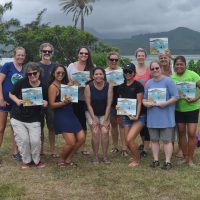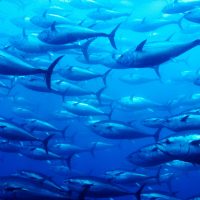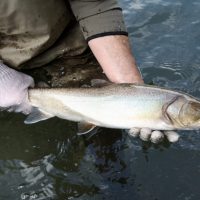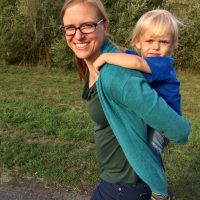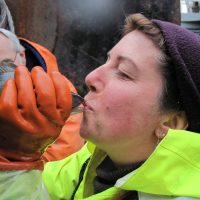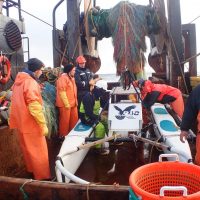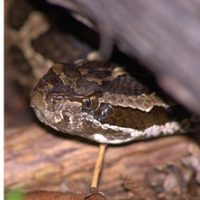Filter Results
Kupe and the Corals: bringing science to life for kids
“I wanted to leave something behind to share with these kids. That’s why for me, it was important to have it be translated into Tahitian.”
— UW School of Aquatic and Fishery Sciences’ Jackie Padilla-Gamiño
Habitat preservation is a critical part of good ocean fisheries management
Marine fisheries management aims to keep fish populations at sustainable levels while producing seafood. Fisheries that are assessed to be overfished must have their populations rebuilt to sustainable levels by reducing catches to lower levels. Usually the assessment of status relies on a complicated fisheries stock assessment model, sort of like a weather forecast for fisheries, that estimates the level of sustainable catch that can be taken from a fisheries population.
Read moreEstuary provides refuge after dam removal for bull trout
Bull trout use a bewildering array of strategies to aid in their survival, from remaining in streams their whole lives, like rainbow trout, to spending part of their lives in the ocean before returning to streams to spawn, just as salmon do. Bull trout are present in only one of two neighboring rivers in the Olympic peninsula, Washington state, and in this one (the Elwha River), two large dams were removed during the period 2011-2014.
Read moreHow far do river fish move?
For decades, fish researchers believed in Gerking’s “restricted movement paradigm”, thinking that river-dwelling fish largely stay in the same place and rarely venture forth. But in recent decades, ecologists have harnessed the power of both advanced tags and improved genetic methods to directly estimate movement distances and average home ranges of different fish species. Now, a new paper has gathered in one place data from more than 200 direct movement studies and more than 200 genetic studies to estimate how far river fish more on average.
Read moreCentennial Story 34: Mike Sigler (PhD, 1993)
When I went to college, my plan was to become a veterinarian. But then I went to the Shoals Marine Laboratory off the coast of Maine between my junior and senior years and my life turned in another direction. I loved the power of the ocean and was curious about the interrelationships of the animals and plants (or should I say fish and phytoplankton).
Read moreCentennial Story 33: Lauren Rogers (PhD, 2010)
“Why fish?” asked my Grandma, perplexed, as I told her I was starting a PhD program at UW. Apparently studying trees was completely normal (my brother was in forestry), but fish were too… slimy. Admittedly, I’d never been a fish lover, but I thought that the field of fisheries would let me apply my interests in oceanography and ecology to problems that matter very directly for humans – and that this would keep me motivated through grad school and beyond.
Read moreCentennial Story 31: Susanne McDermott (MS, 1994; PhD, 2003)
The story about how I arrived at SAFS takes some twists and turns, but all of them were interesting and eventually led me to the University of Washington and SAFS before I started working at the Alaska Fisheries Science Center (AFSC).
I grew up in landlocked southern Germany in a very small town. I spent much of my childhood at a local farmers’ stable and in the neighboring woods, and I knew from an early age that I wanted to be a biologist.
Centennial Story 30: Loh-Lee Low (BS, 1970; MS, 1972; PhD, 1974)
I started as a freshman at the College of Fisheries in the fall of 1968. I was very fortunate to have been awarded a Malaysian Government scholarship to study Fisheries in the United States when I graduated from High School in Malaysia. The scholarship was the blessing that molded my life. I knew I had to succeed. So I studied. I fast-tracked myself to earn three degrees at the University of Washington and managed to graduate summa cum laude in 1970.
Read moreCentennial Story 29: Stanislaw (Stan) Kotwicki (PhD, 2014)
I grew up in Poland far away from the ocean. I remember my mom often bringing home pollock fillets for dinner. During that time (early 1980s), pollock was often the only fish we could get in the store. Later, during my studies on biological oceanography at the University of Gdansk (UG), I found out that pollock in Polish stores came mostly from the Bering Sea.
Read moreWhole DNA sequences should be used to improve conservation decisions
The U.S. Endangered Species Act has saved or recovered many species, and is recognized as one of the most powerful laws in the world for protecting the environment. The primary aim of the Act is to ensure that populations and species persist, and to conserve genetic variation in population. But little attention is paid to the adaptive potential of populations—the capability of populations to evolve when faced with new selective pressures—even though new genetic methods of sequencing the entire DNA of organisms are now cheaper and easier than ever before.
Read more